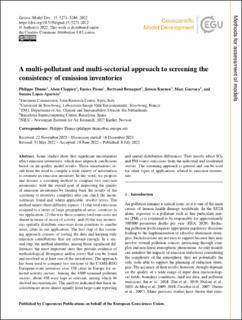| dc.contributor.author | Thunis, Philippe | |
| dc.contributor.author | Clappier, Alain | |
| dc.contributor.author | Pisoni, Enrico | |
| dc.contributor.author | Bessagnet, Bertrand | |
| dc.contributor.author | Kuenen, Jeroen | |
| dc.contributor.author | Guevara, Marc | |
| dc.contributor.author | Lopez-Aparicio, Susana | |
| dc.date.accessioned | 2022-09-30T07:55:13Z | |
| dc.date.available | 2022-09-30T07:55:13Z | |
| dc.date.created | 2022-08-01T13:33:00Z | |
| dc.date.issued | 2022 | |
| dc.identifier.citation | Geoscientific Model Development. 2022, 15 (13), 5271-5286. | en_US |
| dc.identifier.issn | 1991-959X | |
| dc.identifier.uri | https://hdl.handle.net/11250/3022717 | |
| dc.description.abstract | Some studies show that significant uncertainties affect emission inventories, which may impeach conclusions based on air-quality model results. These uncertainties result from the need to compile a wide variety of information to estimate an emission inventory. In this work, we propose and discuss a screening method to compare two emission inventories, with the overall goal of improving the quality of emission inventories by feeding back the results of the screening to inventory compilers who can check the inconsistencies found and, where applicable, resolve errors. The method targets three different aspects: (1) the total emissions assigned to a series of large geographical areas, countries in our application; (2) the way these country total emissions are shared in terms of sector of activity; and (3) the way inventories spatially distribute emissions from countries to smaller areas, cities in our application. The first step of the screening approach consists of sorting the data and keeping only emission contributions that are relevant enough. In a second step, the method identifies, among those significant differences, the most important ones that provide evidence of methodological divergence and/or errors that can be found and resolved in at least one of the inventories. The approach has been used to compare two versions of the CAMS-REG European-scale inventory over 150 cities in Europe for selected activity sectors. Among the 4500 screened pollutant sectors, about 450 were kept as relevant, among which 46 showed inconsistencies. The analysis indicated that these inconsistencies arose almost equally from large-scale reporting and spatial distribution differences. They mostly affect SO2 and PM coarse emissions from the industrial and residential sectors. The screening approach is general and can be used for other types of applications related to emission inventories. | en_US |
| dc.language.iso | eng | en_US |
| dc.rights | Navngivelse 4.0 Internasjonal | * |
| dc.rights.uri | http://creativecommons.org/licenses/by/4.0/deed.no | * |
| dc.title | A multi-pollutant and multi-sectorial approach to screening the consistency of emission inventories | en_US |
| dc.title.alternative | A multi-pollutant and multi-sectorial approach to screening the consistency of emission inventories | en_US |
| dc.type | Peer reviewed | en_US |
| dc.type | Journal article | en_US |
| dc.description.version | publishedVersion | en_US |
| dc.rights.holder | © Author(s) 2022. | en_US |
| dc.source.pagenumber | 5271-5286 | en_US |
| dc.source.volume | 15 | en_US |
| dc.source.journal | Geoscientific Model Development | en_US |
| dc.source.issue | 13 | en_US |
| dc.identifier.doi | 10.5194/gmd-15-5271-2022 | |
| dc.identifier.cristin | 2040353 | |
| dc.relation.project | NILU - Norsk institutt for luftforskning: 120011 | en_US |
| cristin.ispublished | true | |
| cristin.fulltext | original | |
| cristin.fulltext | original | |
| cristin.qualitycode | 2 | |

